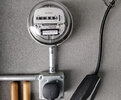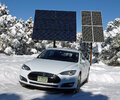For my home system, in late 2018, I did an expansion from 5 kW to to just over 9 kW of solar panels. Since then, I've produced more electricity than I've consumed and have just been paying the base $14.50/month grid-connect service fee. For example, in April, I overproduced by 381 kWh, and in May, it was 404 kWh. I switched the HVAC in the house from Heat to Cool yesterday, so usage in the house will go up a little. With working from home for the foreseeable future, my electricity use may be a little higher this year than last year. Time will tell if the expansion was enough to go 2 whole years producing more than I consumed.






